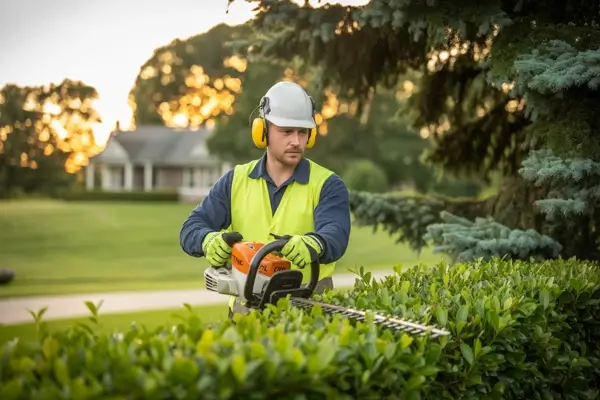Hedge cutting, strimming and lawn mowing Risk Assessment

A comprehensive Risk Assessment for hedge cutting, strimming and lawn mowing.
A lawn cutter, commonly referred to as a grass cutter or lawn care technician, plays a crucial role in maintaining and enhancing residential and commercial landscapes. The primary responsibilities of this position encompass a wide range of tasks designed to achieve a visually appealing and healthy lawn.
One of the primary duties involves mowing grass, where the technician utilises various types of mowers, including push mowers, riding mowers, and robotic mowers. Each type of mower is selected based on the size of the area and specific customer needs, allowing for grass to be cut to a precise height for optimal health and aesthetics.
In addition to mowing, the lawn cutter utilises hedge trimmers or manual shears to carefully maintain the shape, size, and overall health of hedges and bushes. Regularly trimming these plants not only promotes healthy growth but also ensures that they remain visually appealing throughout the seasons.
Weed management is another essential aspect of lawn care. Lawn care technicians remove unwanted weeds manually or apply targeted herbicides to control their growth effectively, ensuring that flowers and grass can thrive without competition for nutrients.
To maintain a clean and tidy environment, lawn cutters are responsible for picking up fallen leaves, branches, and other debris. This task is crucial during seasonal changes and after storms, as it helps maintain the overall health of the lawn and landscape.
Trimming grass along the edges of sidewalks, driveways, and other hard surfaces is another crucial responsibility. This task requires precision and attention to detail, as neat edges significantly enhance the overall appearance of the landscape. For hard-to-reach areas or along fences, technicians utilise strimmers, also known as weed trimmers, which allow for effective cutting in tight spaces.
In addition to maintenance tasks, lawn cutters may also apply fertilisers and aerate the soil to encourage robust grass growth. Proper fertilisation provides essential nutrients, while aeration alleviates soil compaction, allowing air, water, and nutrients to penetrate deeper into the root system.
Additionally, lawn care technicians may strategically apply pesticides or herbicides to control pests and weeds, thereby ensuring the health and longevity of the lawn. This may require knowledge of local regulations regarding chemical applications and an understanding of safe practices.
This document is:
- Recognised by local authorities
- Recognised by principal contractors
- Suitable for CDM sites
- Approved by H&S managers
It increases your chance of winning tenders and has been written by trained health and safety professionals.
If you want others to have confidence in your company, download and buy the proper documents today.
As with all our documents, our risk assessments are in Word™ format and available for instant download and use. You only need to buy them once.
Once you buy and download this document, it's yours to use repeatedly.
Download this risk assessment add your company details, and use it immediately.
Give people confidence in you, your company, your products and services.
Some sample text from this document reads:
'RSIs (Repetitive strain injuries)'
Any individual who carries out repetitive tasks may experience pain in various joints and muscle groups
• Avoid forceful or repetitive tasks where possible
• Ensure the work area is set up correctly
• Avoid arching back or squatting for extended periods
• Avoid stretching and overreaching.
Why not browse the HSEDocs catalogue of method statements, risk assessments, COSHH assessments, or industry-specific packages?
GET THIS DOCUMENT
£8.99+VAT
- Available in Word™
- Fully customisable
- Add your Company Logo
- UK & EU Compliant

 CART
CART 